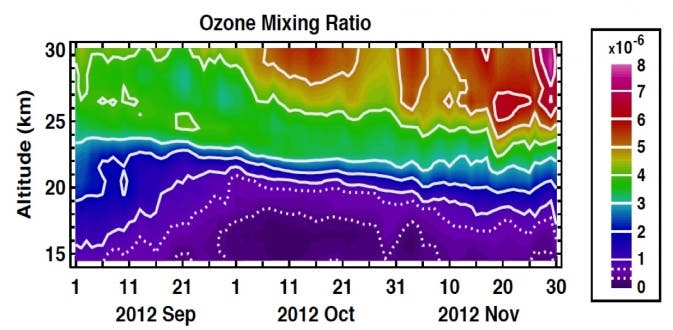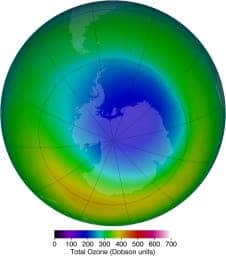NASA scientists have revealed new data on the ozone hole that forms each year above Antarctica and found that the decrease of chlorine in the atmosphere hasn’t had any significant positive impact. Chlorine is the most dangerous substance for the ozone layer.
20 years ago, the Montreal Protocol was installed. The Montreal Protocol on Substances that Deplete the Ozone Layer is an international treaty designed to protect the ozone layer and reduce or even eliminate the production of substances which cause damage to the ozone layer. However, two new studies show that despite an apparent reduction in the quantity of chlorine and other such substances, two new studies show that signs of recovery are not yet present.
“Ozone holes with smaller areas and a larger total amount of ozone are not necessarily evidence of recovery attributable to the expected chlorine decline,” said Susan Strahan of NASA’s Goddard Space Flight Center in Greenbelt, Md. “That assumption is like trying to understand what’s wrong with your car’s engine without lifting the hood.”
In order to gather this information, they used satellites to peek through the ozone hole. Strahan and Natalya Kramarova, also of NASA Goddard, turned to data from the NASA-NOAA Suomi National Polar-orbiting Partnership satellite and used the satellite’s Ozone Mapper and Profiler Suite’s Limb Profiler to create a map that shows how the amount of ozone varied with altitude throughout the stratosphere during the 2012 season.
The map revealed not only that the hole isn’t shrinking, but that it is much more complex than previously thought.
“Our work shows that the classic metrics based on the total ozone values have limitations – they don’t tell us the whole story,” Kramarova said.

A look inside the 2012 ozone hole with the Ozone Mapper and Profiler Suite shows how the build-up of ozone (parts per million by volume) in the middle stratosphere masks the ozone loss in the lower stratosphere.
Image Credit: NASA
Basically, classic metrics show that the hole has improved since the Montreal protocol. But in reality, weather parameters (winds, most notably) are responsible for the increased ozone and resulting smaller hole. This is what this study has shown: that winds can have a significant impact on the ozone hole and apparent improvements were only apparent weather-caused changes.
The only good thing is that chlorine emissions have been going down; at a pretty slow pace, but they’ve been going down. However, until chlorine levels in the lower stratosphere decline below the early 1990s level (which is something expected to happen anywhere between 2015-2030) temperature and winds will continue to dictate the variable area of the hole in any given year.
“We are still in the period where small changes in chlorine do not affect the area of the ozone hole, which is why it’s too soon to say the ozone hole is recovering,” Strahan said. “We’re going into a period of large variability and there will be bumps in the road before we can identify a clear recovery.”










